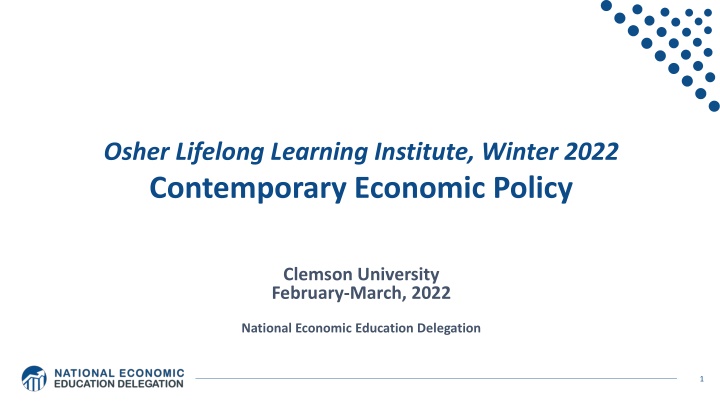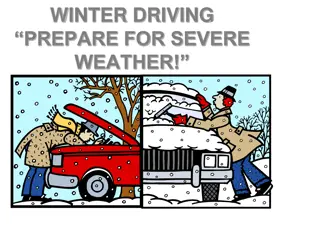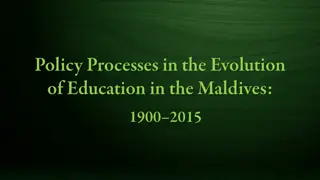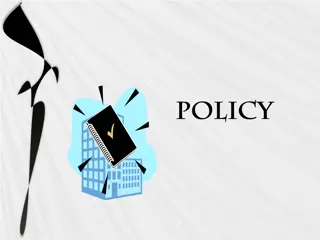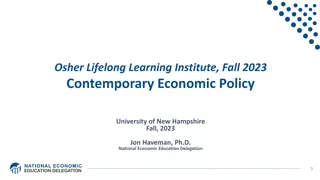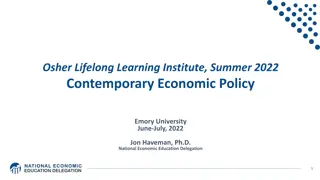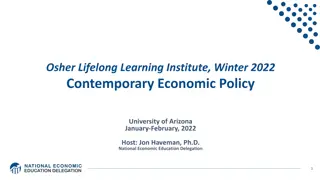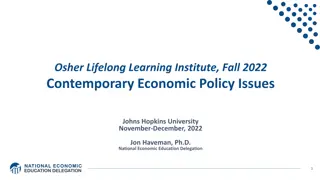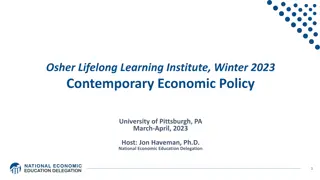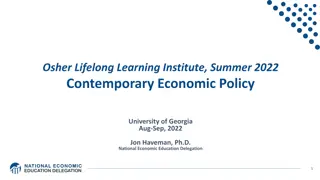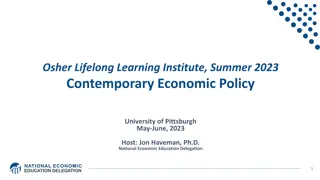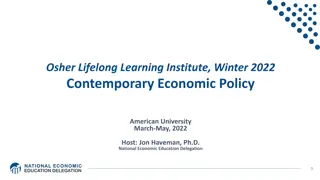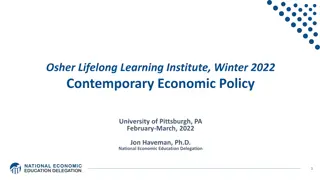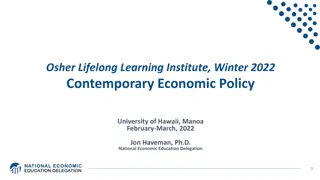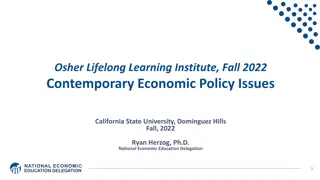Contemporary Economic Policy at Osher Institute: Winter 2022
Dive into the latest economic trends in the Winter 2022 session of the Osher Lifelong Learning Institute. Explore topics such as Coronavirus Economics, Immigration Economics, US Economy, and more. Engage with expert speakers and discover insights on critical economic issues shaping our world today.
Download Presentation

Please find below an Image/Link to download the presentation.
The content on the website is provided AS IS for your information and personal use only. It may not be sold, licensed, or shared on other websites without obtaining consent from the author.If you encounter any issues during the download, it is possible that the publisher has removed the file from their server.
You are allowed to download the files provided on this website for personal or commercial use, subject to the condition that they are used lawfully. All files are the property of their respective owners.
The content on the website is provided AS IS for your information and personal use only. It may not be sold, licensed, or shared on other websites without obtaining consent from the author.
E N D
Presentation Transcript
Osher Lifelong Learning Institute, Winter 2022 Contemporary Economic Policy Clemson University February-March, 2022 National Economic Education Delegation 1
Available NEED Topics Include: Coronavirus Economics Immigration Economics US Economy Housing Policy Climate Change Federal Budgets Economic Inequality Federal Debt Economic Mobility Black-White Wealth Gap Trade and Globalization Autonomous Vehicles Minimum Wages US Social Policy 2
Course Outline Contemporary Economic Policy - Week 1 (2/28): US Economy & Coronavirus Economics - Week 2 (3/7): Economic Inequality (Brian Peterson, Central College) - Week 3 (3/14): Cryptocurrencies (Geoffrey Woglom, Amherst College) - Week 4 (3/21): Autonomous Vehicles (Jon Haveman, NEED) 3
Submitting Questions Please submit questions in the chat. - I will try to handle them as they come up, but may take them in a bunch as time permits. We will do a verbal Q&A once the material has been presented. - And the questions in the chat have been addressed. OLLI allowing, we can stay beyond the end of class to have further discussion. 4
Driving Change Autonomous Vehicles Big Impact National Economic Education Delegation Jon Haveman, Ph.D. March 21, 2022
Credits and Disclaimer This slide deck was authored by: - Jon Haveman, NEED This slide deck was reviewed by: - Ronald Fisher, Michigan State University - William F. Fox, University of Tennessee, Knoxville Disclaimer - NEED presentations are designed to be nonpartisan. - It is, however, inevitable that the presenter will be asked for and will provide their own views. - Such views are those of the presenter and not necessarily those of the National Economic Education Delegation (NEED). 6
Outline Where does the AV path lead? Transition Policy/Planning Issues Major Economic/Development Changes Environmental Implications
Growth Path McKinsey & Company
McKinsey isnt Always Spot On "In 1980, McKinsey & Company was commissioned by AT&T to forecast cell phone penetration in the U.S. by 2000. - The consultant s prediction, 900,000 subscribers, - was less than 1% of the actual figure, 109 Million. Professor Angel Lozano, 2014 10
Two Important Questions: 1. When will Transportation as a Service (TaaS) be available? 2. How quick will the transition be? 11
WHEN? What do the headlines say? NVIDIA to introduce level-4 enabling system by 2018 First autonomous Toyota to be available in 2020 Volkswagen expects first self driving cars on the market by 2019 Elon Musk now expects first fully autonomous Tesla by 2019, approved by 2021 Audi to introduce a self- driving car by 2020
Wildly Optimistic, But 40+ Corporations Working On Autonomous Vehicles 13
WHEN? What is possible? By 2025 (?) Potentially 95% of VMT by 2035. Last 5% is going to be very difficult to achieve. Is this possible? - Horses to cars: 10 years early 1900s - But adoption of EVs is so slow! - Adoption of AVs will be rapid.
Forecast Timing may be off. But the point is: RAPID ADOPTION! The Big Unknown 16
Trucking Highly Fertile Ground Long haul trucking is likely the first place we will see it adopted. - Reduces costs associated with drivers. - End run around limits on hours of driving. Where does it stand? - Lots of trials underway. - TuSimple actively building a long haul network. - Waymo focused more on last mile/local delivery. 19
But, will it be: Heaven? OR Hell?
Hell Primarily individual private car ownership Much as today. Internal combustion engines Why Hell? Dramatically increased VMT and pollution. Potentially increased congestion Parking.
Two Adults and a Child: Morning Miles Parking Office 1 1 2 3 4 School Home 5 7 6 Office 2 And this is just the morning .. 25
Heaven Vehicle ownership will be very limited Private ownership for those with specialized vehicle needs. Fleet ownership will serve everybody else. Engines: electric Insurance: product liability Not clear when we will get there, but this is the likely model. 2030 for widespread adoption in many regions.
Why is this Heaven? Not only autonomous, but: - Shared - Connected - Green Far fewer cars in existence. - Better resource utilization. VMT could go up or down, but more productive than in Hell. Congestion effects unclear, but likely reduced. - Right-sized vehicles, platooning, sharing, V2V communication Minimal need for parking.
Transition Short term: Tesla model of highway autonomy - Level 2, adaptive cruise control Medium term: - short period of personal vehicle ownership with level 3 capability - introduction of independent private fleets Uber, Lyft, Google, nuTonomy, etc., with level 4/5 capability Long term: - Personal vehicle ownership is largely a thing of the past
Economics Drives Transition: Private Adoption dividend for private individuals - Eliminate car ownership o Ave annual cost of owning a car: $9,561 o Cost per mile will fall: $0.64 to $0.19 - Repurpose your garage o $50,000 from transition to bedroom Time recovery - 50% of Bay Area workforce has a commute in excess of 30 minutes Source: NEED Calculations and AAA Driving Cost Fact Sheet, 2020
Economics Drives Transition: Public Economic and social costs associated with human drivers are enormous: - ACCIDENTS: o Drive 25% of congestion. o Result in 40,000 deaths. o And 2 million injuries. o 90+% caused by human error. - Increased productivity from not driving. - Costs of human drivers estimated at up to $1.3 TRillion each year
Potential Savings Morgan Stanley
Public Policy/Planning Issues Government buy-in: - Essential gov t must encourage progress - Difficult because of displacement issue Important transitional issues: - What infrastructure should be developed? - What to do about public transportation? - What to do with all of the parking spaces?
Responding to the coming changes: Transportation organizations must develop a forecast for adoption in their specific geography - San Francisco faster than Chicago - Chicago faster than Fresno - Fresno - faster than Kansas How does this affect the ROR calculation on projects? - Highway expansion? Public Transportation?
Encourage Change Mobility and equity considerations. - Elderly/disabled/impoverished Safety: only way to reduce traffic fatalities is by coordinated effort. Productivity: reduced congestion. Environment: speed transition to electric vehicles. These are all societal benefits that come about too slowly if the private market is left to itself.
Mobility and Equity Mobility - Handicapped - Elderly - Lower income Equity - Public Transportation often does not work well for low-income workers/residential workers o Does not go from residential to residential, but from residential to commercial
Environmental Implications Depends: Heaven or Hell Improved resource utilization More efficient travel - Right sized vehicles - Optimized routes - Reduced congestion - No searching for parking Increased VMT Cleaner technologies - Electric - Lighter vehicles Energy use of onboard electronics - Weight and functional Increased urban sprawl Bottom line: push governments at all levels to embrace and to implement policies deterring private vehicle ownership and zero passenger miles
Incentives Through Policy and Planning Allow vehicles equipped with ACC into HOV lanes - Eventual conversion of HOV lanes to ACC/AV lanes Allow ACC equipped vehicles to travel faster in HOV lanes Subsidize ACC upgrades - Arguably more concrete benefits than electric vehicles Sticks: higher costs of vehicle ownership - Registration fees, VMT taxes, etc. Note: ACC = Adaptive Cruise Control
Interim Summary Transition is coming very quickly! - Most reports are extremely conservative - Apply generally, but faster in many regions. Very important to start incorporating AVs into planning now. - To realize the benefits of AVS. - Sacrifice expansion for maintenance.
What Changes Will This Bring? Disposable income Government finances Transportation Infrastructure Public transportation Employment Housing Parking Potentially dramatic improvements in infrastructure planning and maintenance - Data sharing and integration
Disposable Income Costs $9,282 to own a car Will cost $3,000 to use TaaS Net increase in disposable income of > $6,000 Spread across all households: more than $1 trillion in new spending in the economy Major boost to economic activity - CREATING JOBS!
Government Finances Government finances thrown for a loop: - Revenues up and down: o Parking revenue, tickets, traffic violation revenues o More commercial, retail and residential space - Less spending on road development - More (maybe less) spent on road maintenance o Fewer road miles o but perhaps more VMT
Transportation Demand for transportation will likely increase significantly: price falls, demand rises - Commutes may increase in distance, but not necessarily in duration - Zero passenger trips will arise o Deliveries At the same time, demand for roadway lane-miles will likely decrease - AVs make significantly more efficient use of space - Front to back and side to side
Infrastructure Focus of transportation infrastructure: - Currently on expansion - Will turn toward: o Maintenance Signage and striping has to be robust TaaS providers push for fewer potholes? o Adding technology Stop lights will be digital as well as visual - Some will disappear: Signs!
Public Transportation Ambiguous implications for public transportation Demand may: - Shrink because of low cost of TaaS - Grow because last mile problem is solved Extensions may be added through contract with TaaS company
Cautionary Tale From Long Ago Automobiles impact on rail: The increasing dominance of cars was also felt by railway companies, which by June 1894 had to start making pricing concessions for transporting goods, even including free transport. - Samuel I. Schwartz, No One at the Wheel, 2018 47
Employment Massive job displacement/relocation (Millions!): - Drivers of all varieties: truck, taxi, delivery - Car production jobs, car parts production jobs - Gas station, vehicle repair, and body shop - Police and fire - Health care workers - And so on
Employment (cont) What jobs will be created? - IT jobs - Retail/Production jobs - ?? Always easier to identify things that will go away than to identify what will pop up in its place. Regardless of where they are created, training programs will be crucial to the transition.
Housing Housing is suddenly easier to build - Issue of traffic congestion is significantly reduced. - Space for new housing is available where parking lots used to be. Existing houses can now accommodate more people: garage to bedroom conversions.
